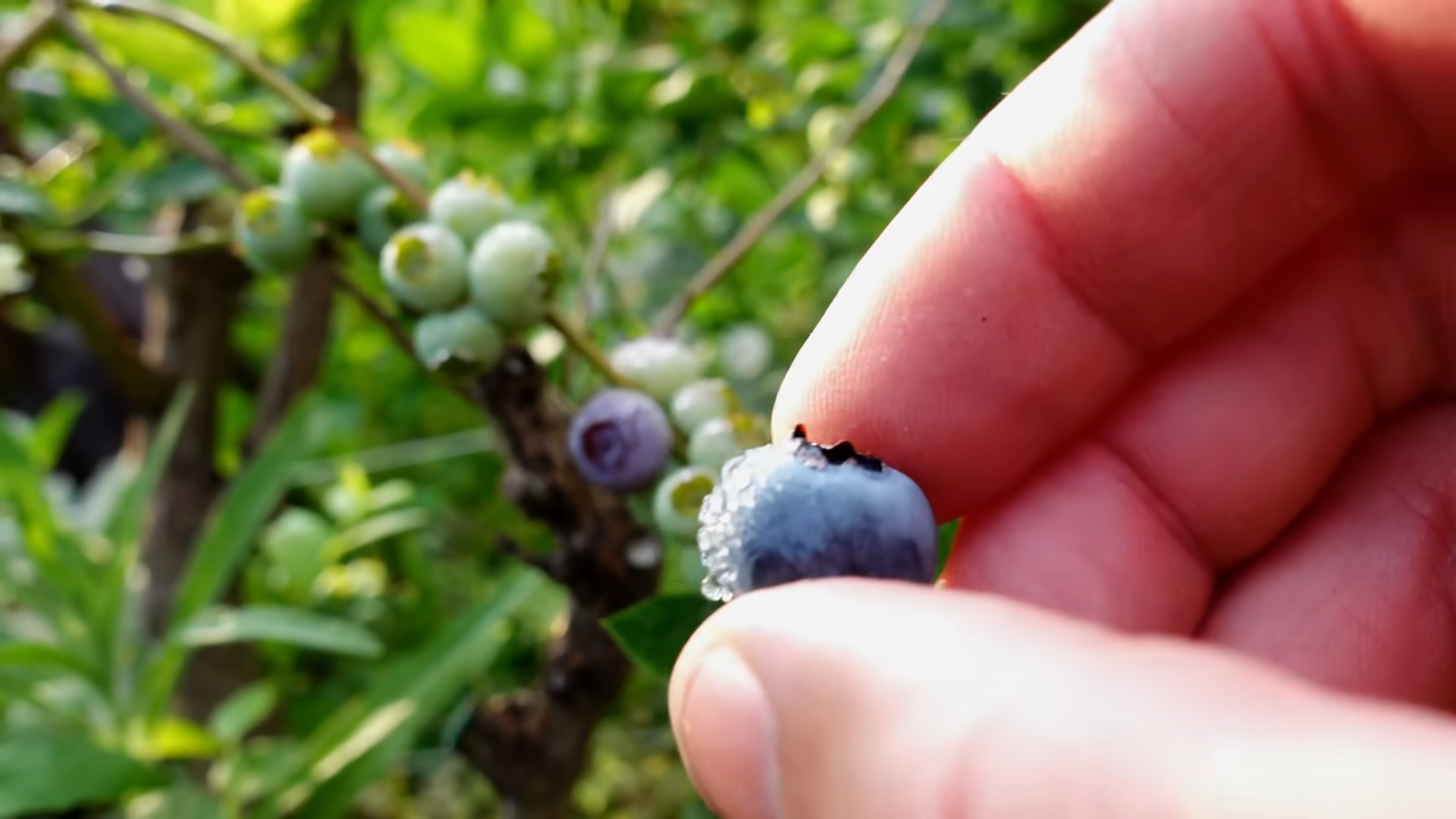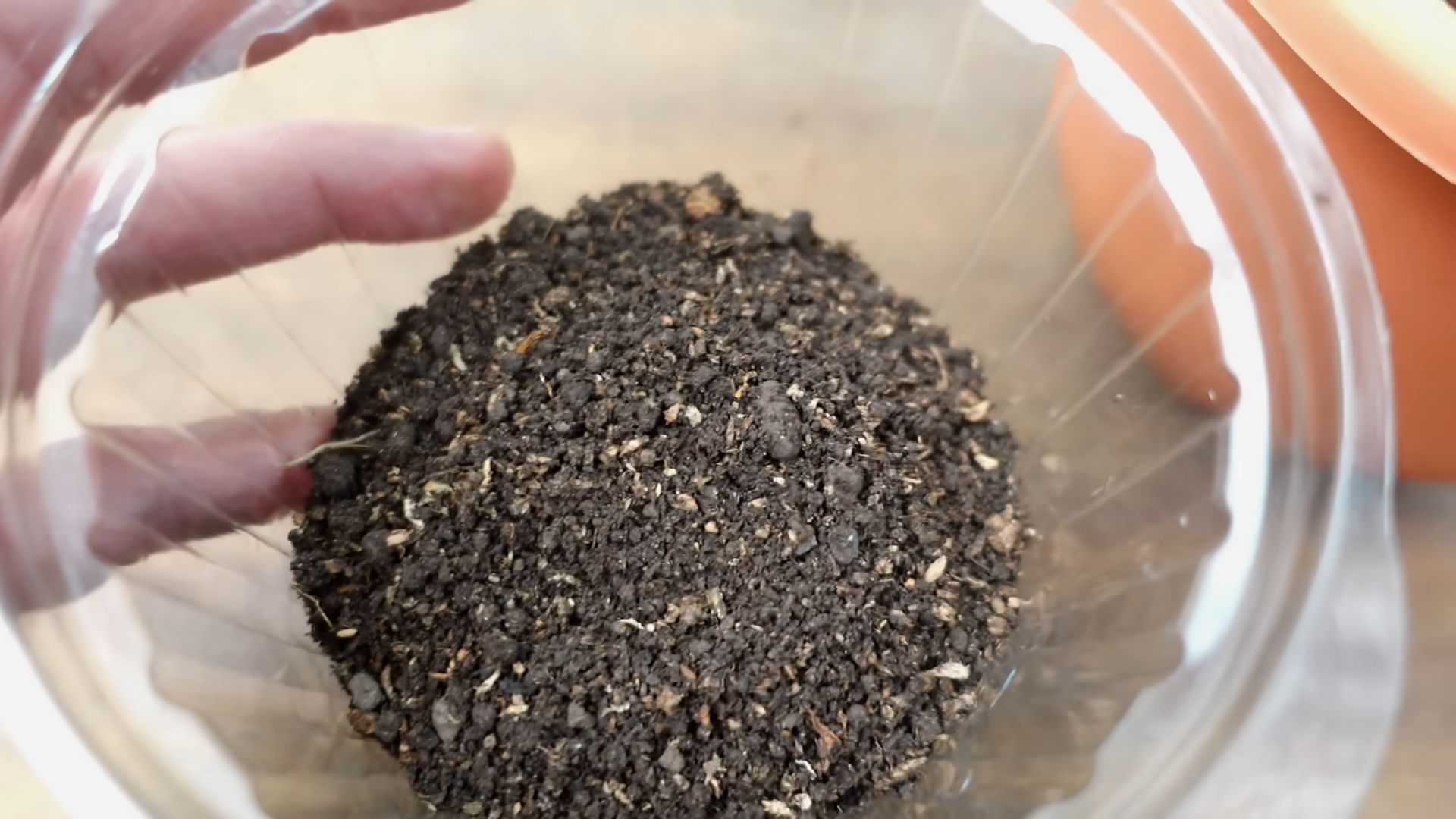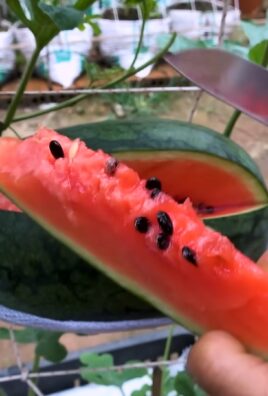Growing Blueberries for Beginners can seem daunting, I know! But trust me, with a few simple tricks and a little know-how, you can be enjoying homegrown, juicy blueberries right from your own backyard. Imagine stepping outside on a warm summer morning and plucking a handful of these antioxidant-rich gems – it’s a truly rewarding experience.
Blueberries have a rich history, not just as a delicious treat, but also as a vital part of indigenous cultures in North America. For centuries, they’ve been used for food, medicine, and even dyes. Today, their popularity continues to soar, and for good reason! They’re packed with nutrients and incredibly versatile in the kitchen.
But why should you bother with the effort of growing blueberries for beginners when you can just buy them at the store? Well, for starters, homegrown blueberries taste infinitely better! Plus, you’ll know exactly what went into growing them, avoiding potentially harmful pesticides and supporting sustainable practices. And let’s be honest, there’s something incredibly satisfying about nurturing a plant from a tiny seedling to a bountiful bush. This DIY guide will equip you with the essential knowledge and easy-to-follow steps to successfully cultivate your own blueberry patch, even if you’re a complete beginner. So, let’s get started and transform your garden into a blueberry paradise!

Growing Blueberries: A Beginner’s Guide to Berry Bliss!
Okay, so you want to grow blueberries? Awesome! Trust me, there’s nothing quite like popping a sun-warmed, juicy blueberry straight from your own bush. It’s easier than you think, but there are a few key things you need to know to get started. I’m going to walk you through everything, from choosing the right variety to keeping those pesky birds away. Let’s get our hands dirty!
Choosing the Right Blueberry Variety
This is probably the most important step, honestly. Blueberries aren’t one-size-fits-all. You need to pick a variety that thrives in your climate. Here’s a breakdown:
* Highbush Blueberries: These are the most common type and are further divided into Northern and Southern Highbush.
* Northern Highbush: These are cold-hardy and perfect for cooler climates (think USDA zones 3-7). They need a good chill period (a certain number of hours below a specific temperature) to produce fruit. Popular varieties include ‘Bluecrop,’ ‘Duke,’ and ‘Elliott.’
* Southern Highbush: These are more heat-tolerant and suitable for warmer climates (USDA zones 7-10). They require less chill time. Great choices are ‘O’Neal,’ ‘Star,’ and ‘Emerald.’
* Rabbiteye Blueberries: These are super vigorous and adaptable, especially to the South (USDA zones 7-9). They’re known for their late-season ripening and require cross-pollination for the best fruit set, so plant at least two different varieties. ‘Tifblue,’ ‘Brightwell,’ and ‘Powderblue’ are excellent options.
* Lowbush Blueberries: These are wild blueberries, smaller in size, and extremely cold-hardy (USDA zones 3-6). They’re often used for ground cover and require very specific acidic soil conditions.
* Half-High Blueberries: As the name suggests, these are a cross between highbush and lowbush, offering a good balance of cold hardiness and fruit size (USDA zones 3-7). ‘Northblue’ and ‘Chippewa’ are popular choices.
How to Choose:
* Know Your USDA Zone: This is crucial! Look up your zone online to determine which varieties will thrive in your area.
* Consider Chill Hours: If you live in a warmer climate, make sure the variety you choose has a low chill hour requirement. Your local nursery can help you with this.
* Think About Cross-Pollination: Rabbiteye blueberries *need* it. Highbush varieties will also benefit from it, leading to larger and more abundant fruit. Plant at least two different varieties that bloom at the same time.
* Fruit Size and Flavor: Do you prefer large, juicy berries or smaller, more intensely flavored ones? Read descriptions and reviews to find varieties that suit your taste.
* Ripening Time: Consider planting early, mid, and late-season varieties to extend your harvest.
Preparing the Soil: Acidity is Key!
Blueberries are acid-loving plants, meaning they need a soil pH between 4.5 and 5.5. This is probably the trickiest part of growing blueberries, but don’t worry, I’ll guide you through it.
* Soil Testing: The first step is to test your soil pH. You can buy a soil testing kit at your local garden center or send a sample to your local extension office for a more detailed analysis.
* Amending the Soil: If your soil pH is too high (above 5.5), you’ll need to amend it. Here are a few options:
* Elemental Sulfur: This is the most common and effective way to lower soil pH. Follow the instructions on the package carefully, as too much sulfur can harm your plants. It takes time to work, so apply it several months before planting.
* Sphagnum Peat Moss: This is a great amendment for blueberries because it’s acidic and helps retain moisture. Mix it generously into the planting hole.
* Acidifying Fertilizer: Use a fertilizer specifically formulated for acid-loving plants, such as azaleas or rhododendrons.
* Drainage: Blueberries need well-draining soil. If your soil is heavy clay, amend it with plenty of organic matter, such as compost or pine bark fines, to improve drainage.
* Sunlight: Blueberries need at least 6 hours of sunlight per day to produce a good crop of fruit. Choose a sunny location for your plants.
Planting Your Blueberry Bushes
Alright, you’ve chosen your varieties and prepped the soil. Now it’s time to plant!
1. Timing: The best time to plant blueberries is in early spring or late fall, when the plants are dormant.
2. Spacing: Space highbush blueberries about 4-5 feet apart, rabbiteye blueberries about 6-8 feet apart, and lowbush blueberries about 2-3 feet apart.
3. Digging the Hole: Dig a hole that’s twice as wide as the root ball and just as deep.
4. Preparing the Roots: Gently loosen the roots of the blueberry bush before planting. If the roots are circling the pot, gently tease them apart or make a few vertical cuts to encourage them to grow outward.
5. Planting: Place the blueberry bush in the hole, making sure the top of the root ball is level with the surrounding soil.
6. Backfilling: Backfill the hole with the amended soil, gently tamping it down to remove air pockets.
7. Watering: Water the newly planted blueberry bush thoroughly.
8. Mulching: Apply a 2-4 inch layer of mulch around the base of the plant to help retain moisture, suppress weeds, and regulate soil temperature. Pine straw, wood chips, or shredded bark are all good choices.
Caring for Your Blueberry Plants
Now that your blueberries are planted, it’s time to give them some TLC.
* Watering: Blueberries need consistent moisture, especially during the growing season. Water deeply and regularly, especially during dry spells. Aim for about 1-2 inches of water per week.
* Fertilizing: Fertilize your blueberry plants in early spring with an acid-loving fertilizer. Follow the instructions on the package carefully. Avoid over-fertilizing, as this can damage the plants.
* Pruning: Pruning is essential for maintaining the health and productivity of your blueberry plants.
* First 3 Years: Focus on removing any dead, damaged, or crossing branches.
* After 3 Years: Prune in late winter or early spring, before new growth begins. Remove about 20% of the oldest canes each year to encourage new growth and fruit production. Also, remove any low-growing branches that touch the ground.
* Weed Control: Keep the area around your blueberry plants free of weeds. Weeds compete with blueberries for water and nutrients. Hand-pull weeds or use a hoe to remove them.
* Pest and Disease Control: Blueberries are generally pest and disease resistant, but they can be susceptible to certain problems.
* Birds: Birds love blueberries just as much as we do! Protect your plants with netting or bird repellent.
* Japanese Beetles: Hand-pick Japanese beetles off your plants or use an insecticide specifically labeled for them.
* Blueberry Maggot: This pest can damage the fruit. Use traps or insecticides to control it.
* Fungal Diseases: Prevent fungal diseases by providing good air circulation and avoiding overhead watering. If you notice any signs of disease, such as leaf spots or stem blight, treat with a fungicide.
Harvesting Your Blueberries
This is the best part! Blueberries are usually ready to harvest in mid-summer.
1. Ripeness: Blueberries are ripe when they are a deep blue color and easily detach from the stem.
2. Harvesting Technique: Gently roll the berries between your thumb and forefinger. If they are ripe, they will easily come off the stem.
3. Frequency: Harvest your blueberries every few days, as they ripen at different times.
4. Storage: Store your freshly picked blueberries in the refrigerator for up to a week. You can also freeze them for longer storage.
Troubleshooting Common Blueberry Problems
Even with the best care, you might encounter some problems along the way. Here are a few common issues and how to fix them:
* Yellowing Leaves: This is often a sign of iron deficiency, which is usually caused by high soil pH. Amend the soil with elemental sulfur or use an acidifying fertilizer.
* Poor Fruit Set: This can be caused by a number of factors, including lack of pollination, frost damage, or nutrient deficiencies. Make sure you have at least two different

Conclusion
So, there you have it! Growing blueberries, while it might seem daunting at first, is entirely achievable, even for beginners. The key lies in understanding their specific needs – acidic soil, consistent moisture, and protection from harsh elements. This DIY approach to soil amendment and plant care empowers you to create the perfect environment for your blueberry bushes to thrive, year after year.
Why is this DIY trick a must-try? Because it’s not just about saving money (though that’s a definite perk!). It’s about taking control of your garden’s ecosystem and providing your blueberries with the exact conditions they crave. Store-bought soil mixes can be inconsistent, and often don’t cater specifically to the high acidity blueberries demand. By crafting your own acidic soil blend, you’re guaranteeing a happy, healthy, and productive blueberry patch. Plus, you’ll gain a deeper understanding of your plants and their needs, making you a more confident and successful gardener.
Consider these variations to personalize your blueberry growing experience:
* Container Gardening: If you’re short on space, blueberries thrive in containers! Use the same DIY acidic soil mix, but choose a large pot (at least 15 gallons) with excellent drainage. Dwarf varieties are particularly well-suited for container growing.
* Companion Planting: Blueberries benefit from companion plants that attract pollinators and deter pests. Consider planting herbs like thyme or rosemary nearby, or flowers like marigolds.
* Variety Selection: Explore different blueberry varieties to find the ones that best suit your climate and taste preferences. Some varieties are sweeter, some are tarter, and some ripen earlier or later in the season. Experiment to discover your favorites!
* Natural Pest Control: Instead of relying on harsh chemicals, explore natural pest control methods. Introduce beneficial insects like ladybugs, or use organic sprays like neem oil to combat common blueberry pests.
Don’t be afraid to experiment and adapt this DIY trick to your specific circumstances. Gardening is a journey of learning and discovery, and every garden is unique. The most important thing is to get started!
We’re confident that with a little effort and attention, you’ll be enjoying a bountiful harvest of delicious, homegrown blueberries in no time. So, grab your gardening gloves, gather your supplies, and embark on this rewarding adventure.
We can’t wait to hear about your experiences! Share your photos, tips, and questions in the comments below. Let’s build a community of blueberry enthusiasts and learn from each other’s successes (and even our failures!). Happy growing!
Frequently Asked Questions (FAQ)
What exactly makes blueberries need acidic soil?
Blueberries are acid-loving plants, meaning they thrive in soil with a pH level between 4.5 and 5.5. This is because the acidic environment allows them to efficiently absorb essential nutrients like iron, manganese, and zinc from the soil. In alkaline or neutral soil, these nutrients become less available to the plant, leading to nutrient deficiencies and stunted growth. The DIY soil mix we discussed helps to create and maintain this crucial acidic environment.
How do I test the pH of my soil?
Testing your soil pH is crucial for successful blueberry growing. You can purchase a soil pH testing kit from most garden centers or online retailers. These kits typically involve mixing a soil sample with a solution and comparing the resulting color to a chart. Alternatively, you can send a soil sample to a local agricultural extension office for a more accurate and comprehensive analysis. Regularly testing your soil pH (at least once a year) will help you monitor its acidity and make adjustments as needed.
What if I don’t have access to peat moss? Are there alternatives?
While peat moss is a common ingredient for acidifying soil, there are alternatives if you can’t find it or prefer not to use it due to environmental concerns. Coco coir, a byproduct of coconut processing, is a good substitute. It retains moisture well and can be slightly acidic. Pine bark fines are another excellent option, as they decompose slowly and release acidity into the soil over time. Just be sure to adjust the proportions of other ingredients accordingly to achieve the desired pH level.
How often should I water my blueberry bushes?
Blueberries need consistent moisture, especially during the growing season. Water deeply whenever the top inch of soil feels dry to the touch. Avoid overwatering, as this can lead to root rot. A good rule of thumb is to water thoroughly once or twice a week, depending on the weather and soil drainage. Mulching around the base of the plants helps to retain moisture and suppress weeds.
When is the best time to plant blueberry bushes?
The best time to plant blueberry bushes is in the early spring or late fall, when the plants are dormant. This allows them to establish their root systems before the heat of summer or the cold of winter. When planting, dig a hole that is twice as wide as the root ball and just as deep. Gently loosen the roots before placing the plant in the hole and backfilling with your DIY acidic soil mix.
How do I protect my blueberries from birds?
Birds love blueberries just as much as we do! To protect your harvest, you can cover your bushes with netting. Be sure to choose a netting with small enough holes to prevent birds from getting through, but large enough to allow pollinators to access the flowers. You can also use bird-scaring devices like reflective tape or decoy owls, but these may not be as effective as netting.
How long does it take for blueberry bushes to produce fruit?
Blueberry bushes typically start producing fruit within one to three years of planting, depending on the variety and growing conditions. It may take several years for them to reach their full production potential. Be patient and continue to provide them with the care they need, and you’ll be rewarded with a bountiful harvest for many years to come.
What kind of fertilizer should I use for blueberries?
Use a fertilizer specifically formulated for acid-loving plants, such as azalea or rhododendron fertilizer. These fertilizers contain ammonium sulfate, which helps to lower the soil pH. Apply the fertilizer in the spring, following the instructions on the package. Avoid over-fertilizing, as this can damage the plants.
How do I prune my blueberry bushes?
Pruning is essential for maintaining the health and productivity of your blueberry bushes. Prune in late winter or early spring, before new growth begins. Remove any dead, damaged, or crossing branches. Also, prune out some of the older, less productive canes to encourage new growth. Aim for an open, airy structure that allows sunlight to penetrate the center of the bush.
My blueberry leaves are turning yellow. What could be the problem?
Yellowing leaves, also known as chlorosis, can be a sign of several problems, including nutrient deficiencies, improper soil pH, or overwatering. Check your soil pH to ensure it’s within the ideal range for blueberries (4.5-5.5). If the pH is too high, amend the soil with sulfur or peat moss. Also, make sure you’re not overwatering the plants. If nutrient deficiencies are suspected, apply a fertilizer specifically formulated for acid-loving plants.




Leave a Comment